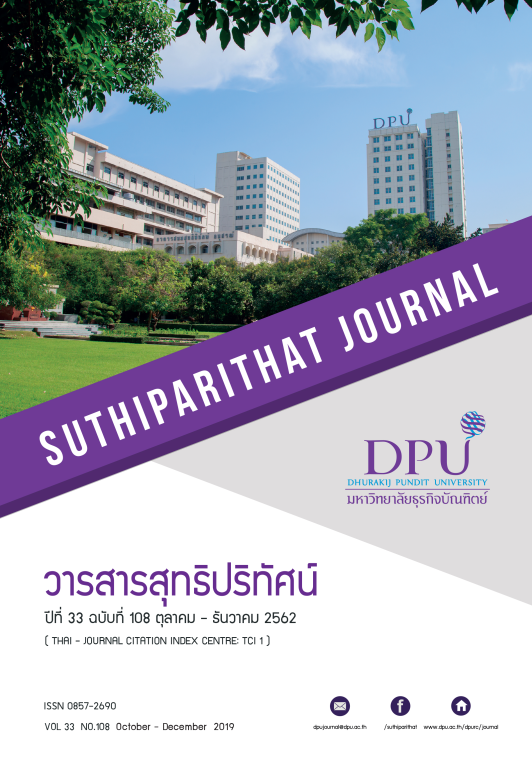ปัจจัยที่มีผลต่อพฤติกรรมผู้บริโภค: การศึกษาผลิตภัณฑ์ชะลอวัยสำหรับดูแลผิวหน้ารูปแบบ D.I.Y
คำสำคัญ:
ชะลอวัย, ผลิตภัณฑ์ดูแลผิวหน้า, ส่วนประสมการตลาด, รูปแบบการดำเนินชีวิต, พฤติกรรมผู้บริโภคบทคัดย่อ
วัตถุประสงค์ในการจัดทำงานวิจัยครั้งนี้เพื่อสำรวจพฤติกรรมผู้บริโภคเพศหญิงที่มีต่อผลิตภัณฑ์ชะลอวัยสำหรับดูแลผิวหน้าโดยแนวคิดการจัดการเชิงปริมาณ (Quantitative Approach) ได้นำมาใช้สำหรับเก็บข้อมูลเพื่อศึกษางานวิจัยในครั้งนี้ ข้อมูลได้ถูกรวบรวมจากแบบสอบถามจำนวน 450 ชุดจากผู้บริโภคเพศหญิงในกรุงเทพฯ และเขตปริมณฑล ข้อมูลที่เก็บได้ถูกนำมาวิเคราะห์โดยใช้หลักการวิเคราะห์ความแปรปรวนทางเดียว (One way ANOVA) ผลการวิจัยในครั้งนี้แสดงให้เห็นว่าผู้หญิงไทยที่มีรายรับสูงและรายจ่ายสูง มีความเต็มใจที่จะซื้อผลิตภัณฑ์ชะลอวัยสำหรับดูแลผิวหน้ามากกว่า และผู้หญิงไทยที่ดูแลผิวพรรณ ให้ความสำคัญกับภาพลักษณ์ของตนเอง และต้องการเป็นที่ยอมรับของสังคมมีความเป็นไปได้สูงที่จะซื้อผลิตภัณฑ์ชะลอวัยสำหรับดูแลผิวหน้า ทั้งตัวผลิตภัณฑ์และราคามีความสำคัญกับจำนวนสินค้าที่ผู้บริโภคจะซื้อและค่าใช้จ่ายเฉลี่ยที่ผู้บริโภคจะจ่ายแต่ละครั้งต่อการซื้อของผู้บริโภค อย่างไรก็ตามงานวิจัยนี้มีข้อจำกัดบางประการ อันดับแรกงานวิจัยฉบับนี้สามารถขยายกลุ่มตัวอย่างผู้บริโภคในภาคอื่น ๆ ในประเทศไทยเพื่อเก็บข้อมูลและได้ผลการวิเคราะห์ข้อมูลที่ถูกต้องมากยิ่งขึ้น อันดับที่สองผลิตภัณฑ์ชะลอวัยสำหรับดูแลผิวหน้าสามารถแยกเป็นประเภทย่อย เช่น เซรั่ม ผลิตภัณฑ์บำรุงรอบดวงตา มาส์ก เป็นต้น ซึ่งจะสามารถให้รายละเอียดของผลการศึกษากับผู้ประกอบการได้มากขึ้น
References
Assawavichairoj, S., & Taghian, M. (2017). Cross-cultural comparison of consumer pre-purchase decision-making. Asia Pacific Journal of Marketing and Logistics, 29(1), 27-46.
Barbalova, I. (2018, 5 March). Five key insights from euromonitor international’s beauty and personal care 2018. Euromonitor International. Retrieved from https://blog.euromonitor.com/five-keyhighlights-euromonitor-internationals-beauty-personal-care-2018/
Bay, S., Petrizzi, R., & Gill, P. (2008). The why of the buy: Consumer behavior and fashion marketing. New York: Fairchild Books.
Bennett, A. R. (1997). The five vs-a buyer’s perspective of the marketing mix. Marketing Intelligence & Planning, 15(3), 151-156.
Cerda, A., García, L., Ortega-Farías, S., & Ubilla, Á. (2012). Consumer preferences and willingness to pay for organic apples. Ciencia e investigación agraria, 39(1), 47-59.
Chen, H. J. (2018). What drives consumers’ mobile shopping? 4Ps or shopping preferences?. Asia Pacific Journal of Marketing and Logistics, 30(4), 797-815.
Chovanová, H. H., Korshunov, A. I., & Babcanová, D. (2015). Impact of brand on consumer behavior. Procedia Economics and Finance, 34, 615–621.
Constantinides, E. (2006). The marketing mix revisited: Towards the 21st century marketing. Journal of Marketing Management, 22(3), 439-450.
Dahana, W., Miwa, Y., & Morisada, M. (2019). Linking lifestyle to customer lifetime value: An exploratory study in an online fashion retail market. Journal of Business Research, 99, 319-331.
Engel, J. F., Blackwell, R. D., & Miniard, P.W. (1986). Consumer behavior (5th ed.). Hinsdale, IL: Dryden.
Farah, A., Zainalabidin, M., & Ismail, A. L. (2011). The influence of socio-demographic factors and product attributes on attitudes toward purchasing special rice among Malaysian consumers. International Food Research Journal, 18(3), 1135-1142.
Ghali, Z. (2019). The antecedents of the consumer purchase intention: Sensitivity to price and involvement in organic product: Moderating role of product regional identity. Trends in Food Science & Technology, 90, 175-179.
Govidnasamy, R., & Italia, J. (1990). Predicting willingness to pay a premium for organically grown fresh produce. Journal of Food Distribution Research, 30(2), 44-53.
Hsu, C., Chang, C., & Yansritakul, C. (2017). Exploring purchase intention of green skincare products using the theory of planned behavior: Testing the moderating effects of country of origin and price sensitivity. Journal of Retailing and Consumer Services, 34, 145-152.
Internal Market, Industry, Entrepreneurship and SMEs -European Commission. (2019). Cosmetics-internal market, industry, entrepreneurship and SMEs-European commission. Retrieved from https://ec.europa.eu/growth/sectors/cosmetics_en.
Johri, L. M., & Sahasakmontri, K. (1998). Green marketing of cosmetics and toiletries in Thailand. Journal of Consumer Marketing, 15(3), 265-281.
Kasikornbank. (2017, 31 January). Thailand’s cosmetic industry. AEC+ Business Advisory. Retrieved from https://www.kasikornbank.com/international-business/en/Thailand/IndustryBusiness/Pages/201701_Thailand_Cosmetic.aspx
Lazer, W. (1963). Lifestyle concepts and marketing. Chicago: American Marketing Association.
Mahmoud, T., Ibrahim, S., Hasaballah, A. H., & Bleady, A. (2017). The influence of green marketing mix on purchase intention: The mediation role of environmental knowledge. International Journal of Scientific and Engineering Research, 8, 1040-1048.
Meng, J., & Pan, P. (2012). Investigating the effects of cosmeceutical product advertising in beauty care decision making. International Journal of Pharmaceutical and Healthcare Marketing, 6(3), 250-266.
Morais, I., Brito, E., & Quinto, R. (2018). Productive consumption changing market dynamics: A Study in Brazilian DIY cosmetics. Latin American Business Review, 19(3-4), 323-347.
Nugroho, A. R., & Irena, A. (2017). The impact of marketing mix, consumer’s characteristics, and psychological factors to consumer’s purchase intention on brand W in Surabaya. iBuss Management, 5(1), 55-69
Paul, J., & Rana, J. (2012). Consumer behavior and purchase intention for organic food. Journal of Consumer Marketing, 29(6), 412-422.
Reynolds, F. D., & Darden, W. R. (1974). Construing life style and psychographics. Chicago: American Marketing Association.
Rundh, B. (2009). Packaging design: creating competitive advantage with product packaging. British Food Journal, 111(9), 988-1002.
Sekaran, U. (1992). Research methods for business – A skill building approach (2nd ed.). United States of America: John Wiley & Sons, Inc.
Stuart, E. (2019). NPD: In prestige, skin care Just keeps growing during Q3 2018 (Global Cosmetic Industry). Retrieved from: https://www.gcimagazine.com/marketstrends/segments/cosmetics/In-Prestige-Skin-Care-Continues-Just-Keeps-Growing-499402641.html
Wolf, M., & McQuitty, S. (2011). Understanding the do-it-yourself consumer: DIY motivations and outcomes. AMS Review, 1(3-4), 154-170.
Wongleedee, K. (2015). Marketing mix and purchasing behavior for community products at traditional markets. procedia. Social and Behavioral Sciences, 197, 2080–2085.
Yang, H. W., & Chang, K. F. (2012). Combining means-end chain and fuzzy ANP to explore customers’ decision process in selecting bundles. International Journal of Information Management, 32(4), 381–395.
Yin, S., Wu, L., Du, L., & Chen, M. (2010). Consumers’ purchase intention of organic food in China. Journal of the Science of Food and Agriculture, 90(8), 1361–1367.
Zhang, B., Fu, Z., Huang, J., Wang, J., Xu, S., & Zhang, L. (2018). Consumers’ perceptions, purchase intention, and willingness to pay a premium price for safe vegetables: A case study of Beijing, China. Journal of Cleaner Production, 197, 1498–1507.
Downloads
เผยแพร่แล้ว
How to Cite
ฉบับ
บท
License
เนื้อหาและข้อมูลในบทความที่ลงตีพิมพ์ในวารสารสุทธิปริทัศน์ ถือเป็นข้อคิดเห็นและความรับผิดชอบของผู้เขียนบทความโดยตรงซึ่งกองบรรณาธิการวารสาร ไม่จำเป็นต้องเห็นด้วย หรือร่วมรับผิดชอบใดๆ
บทความ ข้อมูล เนื้อหา รูปภาพ ฯลฯ ที่ได้รับการตีพิมพ์ในวารสารสุทธิปริทัศน์ ถือเป็นลิขสิทธิ์ของวารสารสุทธิปริทัศน์หากบุคคลหรือหน่วยงานใดต้องการนำทั้งหมดหรือส่วนหนึ่งส่วนใดไปเผยแพร่ต่อหรือเพื่อกระทำการใด ๆ จะต้องได้รับอนุญาตเป็นลายลักษณ์อักษรจากวารสารสุทธิปริทัศน์ก่อนเท่านั้น






